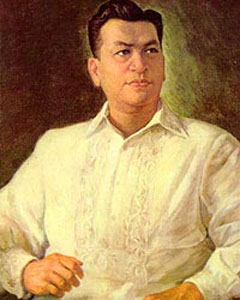 Magsaysay, Ramón (1907-1957), Philippine statesman, born in Iba, and educated at the University of the Philippines and José Rizal College. From 1942 to 1945, during World War II, he organized and led the guerrilla force that fought the Japanese. He was elected (1946) and re-elected (1949) on the Liberal party ticket to the Philippine House of Representatives. An advocate of stronger government action against the Communist-led Hukbalahap (Huk) guerrillas, he was appointed secretary of national defence in 1950. He reorganized and strengthened the army and the constabulary and intensified the campaign to crush Huk resistance, waging one of the most successful antiguerrilla campaigns in modern history by winning over the peasantry and preserving tight military discipline. In 1953 Magsaysay resigned his post as defence secretary and became the presidential candidate of the Nationalist party after criticizing the Liberal government. He was elected president of the Philippines in November 1953, but his efforts to reform the country were frustrated by wealthy landowner interests in the national congress. He died in a plane crash.
Magsaysay, Ramón (1907-1957), Philippine statesman, born in Iba, and educated at the University of the Philippines and José Rizal College. From 1942 to 1945, during World War II, he organized and led the guerrilla force that fought the Japanese. He was elected (1946) and re-elected (1949) on the Liberal party ticket to the Philippine House of Representatives. An advocate of stronger government action against the Communist-led Hukbalahap (Huk) guerrillas, he was appointed secretary of national defence in 1950. He reorganized and strengthened the army and the constabulary and intensified the campaign to crush Huk resistance, waging one of the most successful antiguerrilla campaigns in modern history by winning over the peasantry and preserving tight military discipline. In 1953 Magsaysay resigned his post as defence secretary and became the presidential candidate of the Nationalist party after criticizing the Liberal government. He was elected president of the Philippines in November 1953, but his efforts to reform the country were frustrated by wealthy landowner interests in the national congress. He died in a plane crash. In 1953 the government attempted unsuccessfully to end the Huk rebellion by a peace parley with the rebel leaders. In the presidential elections, held on November 10, former Defence Minister Ramón Magsaysay won a decisive victory over the incumbent Quirino, and because of his vigorous conduct of the campaign against the Huks, the back of the rebellion was broken, although it was not entirely suppressed.
Congress approved, on August 11, 1955, legislation empowering President Magsaysay to break up large landed estates and distribute the land to tenant farmers. On September 6 the Philippines and the United States concluded a trade agreement on private US investment in Philippine enterprises.
In the mid-1950s the United States and the Philippines jointly acknowledged Philippine ownership of US military bases in the islands. The Philippine Senate also ratified the peace treaty with Japan and a Philippine-Japanese agreement providing for US$800 million in Japanese reparations.
Magsaysay died on March 17, 1957, in an air crash, and the next day Vice-President Carlos P. Garcia was sworn in as President. In June a statute outlawing the Communist Party was promulgated. The statute provided a maximum sentence of death for active party membership but allowed surrender without penalty within 30 days after promulgation. Some 1,400 holdouts of the Huk movement surrendered. Garcia was subsequently elected president, and Diosdado Macapagal, an opposition Liberal Party candidate, was elected Vice-President. Macapagal was elected President in 1961, but in the elections of 1965 he lost to the Nationalist candidate, Ferdinand Marcos.
Magsaysay was elected president of the Philippines in 1953 and served four years in office. Magsaysay was a strong opponent of the Communist-led Huk guerrillas, and he reorganized and strengthened the armed forces in a campaign to crush them. He was killed in a plane crash in 1957.
No comments:
Post a Comment